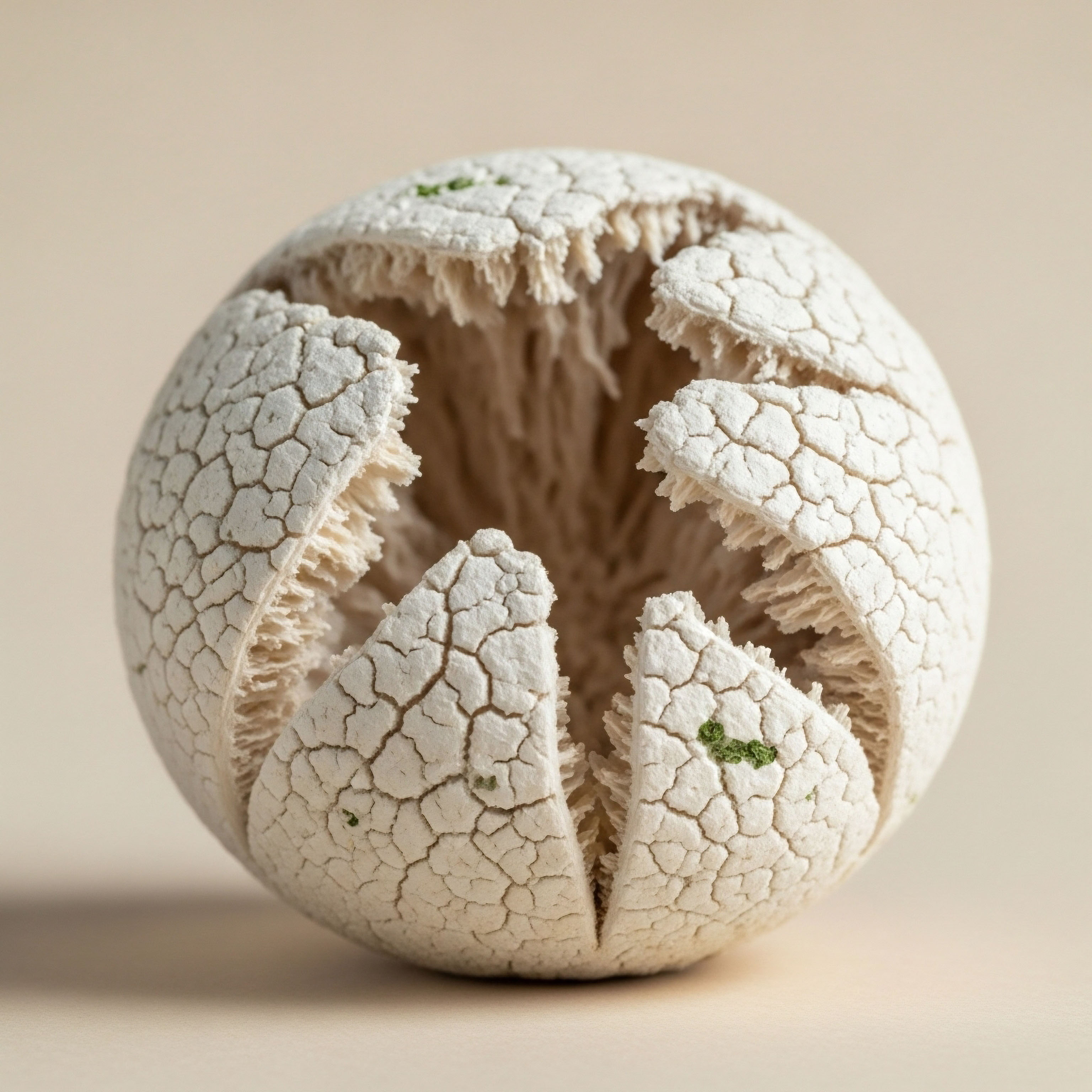

Fundamentals
You feel it before you can name it. A persistent drag on your energy, a subtle fog clouding your thoughts, or the frustrating realization that your body is no longer responding the way it once did. You follow a clean diet and maintain a consistent exercise regimen, yet a disconnect remains between your efforts and your results.
This lived experience is a valid and vital piece of data. It signifies a disruption in your body’s internal communication system, a network of profound complexity and elegance governed by hormones. Understanding this system is the first step toward reclaiming your biological sovereignty.
Your body operates as a coherent whole, orchestrated by the endocrine system. Think of this system as a highly sophisticated messaging service. Hormones are the chemical letters, carrying precise instructions from glands to target cells throughout your body. Cellular receptors are the designated recipients, designed to receive these letters and execute their commands.
This constant dialogue dictates everything from your metabolic rate and stress response to your mood and reproductive health. When this communication flows seamlessly, you experience vitality. When the signals become faint, corrupted, or are sent at the wrong times, the system begins to lag, producing the very symptoms that initiated your search for answers.
The endocrine system functions as the body’s primary communication network, using hormones to transmit vital instructions between glands and cells.
At the heart of sexual health and vitality lies a central command unit known as the Hypothalamic-Pituitary-Gonadal (HPG) axis. This is a classic biological feedback loop. The hypothalamus, a region in your brain, sends a signal (Gonadotropin-Releasing Hormone or GnRH) to the pituitary gland.
The pituitary, in turn, releases Luteinizing Hormone (LH) and Follicle-Stimulating Hormone (FSH), which then travel to the gonads (testes in men, ovaries in women). This final signal instructs the gonads to produce testosterone or estrogen and progesterone. The circulating levels of these sex hormones are then monitored by the brain, which adjusts its initial signals to maintain a state of equilibrium. It is a dynamic, self-regulating architecture that, for a time, works with remarkable precision.

The Interconnected Pillars of Wellness
This finely tuned system does not operate in a vacuum. It is exquisitely sensitive to its environment, both internal and external. The quality of your lifestyle provides the foundational support for this entire hormonal architecture. These are not mere suggestions for healthy living; they are non-negotiable inputs required for optimal endocrine function. Deficiencies in these areas create static in the communication lines, weakening the system’s ability to self-regulate and making it more susceptible to age-related decline.
- Nutrient-Dense Diet A diet rich in high-quality proteins, healthy fats, and micronutrients provides the raw materials for hormone production. Amino acids are the literal building blocks of peptide hormones, while cholesterol is the precursor to all steroid hormones, including testosterone and estrogen.
- Resistance Training Meaningful physical stress from weight-bearing exercise is a powerful stimulus for the endocrine system. It directly signals muscles to grow, improves the body’s sensitivity to insulin, and can stimulate the release of both testosterone and growth hormone. Critically, it increases the sensitivity and density of hormone receptors, making your cells better “listeners” to the hormonal messages already present.
- Restorative Sleep The majority of the body’s repair and hormonal regulation occurs during deep sleep. This is when the brain clears metabolic waste, consolidates memory, and releases key anabolic hormones like Growth Hormone. Chronic sleep deprivation disrupts this process and elevates the stress hormone cortisol, which can directly interfere with the function of the HPG axis.
When lifestyle alone is insufficient to restore balance, either due to significant age-related decline or other physiological factors, clinical protocols serve as a powerful tool to re-establish a healthy biochemical baseline. These interventions are designed to restore the hormonal signals to a level that supports optimal function.
They provide the necessary “hardware” upgrade, delivering the precise hormonal messages your body is struggling to produce on its own. The synergy is clear ∞ clinical protocols restore the signal, and lifestyle interventions ensure the body can hear and respond to that signal effectively.

Understanding Key Hormonal Players
To navigate this landscape, it’s helpful to understand the roles of the primary hormones involved in these discussions. While they are often categorized as “male” or “female,” they are present and necessary in both sexes, simply in different concentrations.
| Hormone | Primary Functions | Common Symptoms of Imbalance |
|---|---|---|
| Testosterone | Supports muscle mass, bone density, libido, cognitive function, and motivation. | Fatigue, decreased muscle mass, weight gain, low libido, brain fog. |
| Estrogen (Estradiol) | Regulates menstrual cycles, supports bone health, cognitive function, and skin elasticity. | Hot flashes, night sweats, vaginal dryness, mood swings, irregular cycles. |
| Progesterone | Prepares the uterus for pregnancy, balances estrogen, has calming effects, and supports sleep. | Anxiety, insomnia, irregular cycles, heavy bleeding, PMS symptoms. |
| Growth Hormone (GH) | Stimulates cellular growth and regeneration, supports metabolism, and maintains body composition. | Increased body fat, decreased muscle mass, poor recovery, low energy, aging skin. |


Intermediate
Advancing from a foundational understanding of hormonal systems to the application of clinical protocols requires a shift in perspective. Here, we move from the ‘what’ to the ‘how’ and ‘why’. The objective of a well-designed clinical protocol is to restore the body’s hormonal milieu to a state of youthful optimal function.
This is achieved through a precise, data-driven, and highly individualized approach that works in concert with, and is amplified by, targeted lifestyle strategies. The clinical intervention sets the stage, and lifestyle determines the quality of the performance.

Male Hormonal Optimization a Systems Approach
For a man experiencing the symptoms of androgen deficiency, or andropause, a standard protocol involves more than simply administering testosterone. A comprehensive approach seeks to support the entire Hypothalamic-Pituitary-Gonadal (HPG) axis to ensure balance and mitigate potential side effects. A typical protocol is built on several key components working in synergy.

The Core Protocol Components
- Testosterone Cypionate This is the primary therapeutic agent, a bioidentical form of testosterone delivered via a slow-acting ester. Weekly intramuscular or subcutaneous injections of 100-200mg are common. This method provides stable blood serum concentrations, avoiding the daily fluctuations associated with topical gels and the peaks and valleys of less frequent injection schedules. The goal is to elevate total and free testosterone levels into the optimal range for a healthy young adult male.
- Gonadorelin This peptide is a synthetic analog of Gonadotropin-Releasing Hormone (GnRH). When exogenous testosterone is introduced, the brain senses high levels and shuts down its own GnRH signal to the pituitary. This, in turn, causes the pituitary to stop sending LH to the testes, leading to testicular atrophy and a shutdown of endogenous testosterone production. Gonadorelin is administered via subcutaneous injection (typically twice weekly) to mimic the natural GnRH pulse from the hypothalamus. This keeps the pituitary signaling the testes, preserving testicular function and maintaining a level of natural hormone production.
- Anastrozole Testosterone can be converted into estradiol (a form of estrogen) via an enzyme called aromatase. While some estrogen is necessary for male health, excessive conversion can lead to side effects like water retention, moodiness, and gynecomastia. Anastrozole is an aromatase inhibitor, an oral medication typically taken twice a week to control this conversion process. Its dosage is carefully titrated based on blood work to keep estradiol within a healthy, balanced range relative to testosterone.
This multi-faceted protocol demonstrates a systems-based philosophy. It restores the primary hormone, supports the integrity of the natural signaling axis, and manages metabolic byproducts. The synergy with lifestyle here is direct. For instance, resistance training has been shown to increase the density of androgen receptors in muscle tissue.
This means that for the same level of circulating testosterone provided by the protocol, a man who engages in regular strength training will experience a more profound effect on muscle mass and strength because his cells are more receptive to the signal.

Female Hormonal Balance a Question of Ratios
Hormonal optimization in women, particularly during the perimenopausal and postmenopausal transitions, is a matter of profound nuance. The goal is to alleviate symptoms and restore well-being by re-establishing the delicate balance between key hormones, primarily estrogens and progesterone, and in many cases, testosterone.
Effective female hormone therapy focuses on restoring the intricate balance and proper ratios between estrogens, progesterone, and testosterone.
Protocols for women are highly individualized based on their menopausal status and specific symptoms. For women still cycling, progesterone may be used in the latter half of the cycle (the luteal phase) to counterbalance estrogen and alleviate symptoms of PMS and anxiety. For postmenopausal women, continuous combined therapy with both estrogen and progesterone is common.

The Role of Testosterone in Women
One of the most effective but often overlooked aspects of female hormonal health is the role of testosterone. Though present in smaller quantities than in men, testosterone is vital for female libido, motivation, muscle mass, and cognitive clarity. As levels decline with age, women can experience a significant loss of vitality.
A common and effective protocol involves low-dose subcutaneous injections of Testosterone Cypionate, typically 10-20 units (0.1-0.2ml) weekly. This small dose is enough to restore testosterone to the upper end of the normal female range, often producing marked improvements in energy, mood, and sexual health. In some cases, long-acting testosterone pellets may be used, which are implanted under the skin and release a steady dose of the hormone over several months.

Growth Hormone Peptide Therapy Restoring the Master Signal
Growth Hormone (GH) is a master hormone that governs cellular repair, metabolism, and body composition. Its production declines steadily with age. While direct injection of recombinant Human Growth Hormone (rHGH) is an option, a more sophisticated and biomimetic approach involves using peptide therapies that stimulate the body’s own pituitary gland to produce and release GH in its natural, pulsatile rhythm.
These therapies utilize two main classes of peptides that work together synergistically:
- GHRH Analogs (Growth Hormone-Releasing Hormone) These peptides, such as Sermorelin and CJC-1295, mimic the body’s natural GHRH. They bind to receptors on the pituitary gland and stimulate it to produce a pulse of GH.
- GHRPs (Growth Hormone-Releasing Peptides) These peptides, including Ipamorelin and Hexarelin, also signal the pituitary to release GH, but through a different receptor (the ghrelin receptor). They amplify the GH pulse created by the GHRH analog and also suppress somatostatin, a hormone that normally inhibits GH release.
The combination of a GHRH analog with a GHRP, such as the popular stack of CJC-1295 and Ipamorelin, is particularly effective. The CJC-1295 determines the size of the GH pulse, while the Ipamorelin increases the number of cells activated to release it.
This combination creates a powerful, natural release of GH that can lead to improved sleep quality, enhanced recovery from exercise, reduced body fat, and increased lean muscle mass. This approach is considered safer and more sustainable than direct rHGH because it works within the body’s existing feedback loops, preserving the natural pulsatile release that is so important for its function.
| Peptide Protocol | Mechanism of Action | Typical Administration | Primary Benefit |
|---|---|---|---|
| Sermorelin | GHRH Analog with a short half-life. | Daily subcutaneous injection at night. | Promotes natural, pulsatile GH release; supports sleep. |
| CJC-1295 / Ipamorelin | Longer-acting GHRH analog combined with a selective GHRP. | Daily subcutaneous injection at night. | Strong, synergistic GH release with minimal side effects. |
| Tesamorelin | Potent GHRH analog approved for visceral fat reduction. | Daily subcutaneous injection. | Specifically targets and reduces visceral adipose tissue. |
| MK-677 (Ibutamoren) | Oral GH secretagogue that mimics ghrelin. | Daily oral capsule. | Convenient oral administration; sustained elevation of GH and IGF-1. |


Academic
A sophisticated evaluation of hormonal health requires moving beyond the primary signaling axes and into the complex ecosystems that modulate hormone synthesis, metabolism, and bioavailability. The intestinal microbiome, a dense and dynamic community of microorganisms, represents a critical regulatory hub in endocrine function.
Specifically, the collection of enteric microbes capable of metabolizing estrogens, termed the “estrobolome,” has a profound and direct impact on systemic estrogen homeostasis. Understanding this gut-hormone axis is essential, as it reveals a mechanism whereby lifestyle choices, particularly diet, directly influence the efficacy and side-effect profile of clinical hormonal protocols.

The Estrobolome a Key Modulator of Estrogen Circulation
Estrogens, after exerting their effects throughout the body, are conjugated in the liver, primarily through glucuronidation. This process attaches a glucuronic acid molecule, rendering the estrogen water-soluble and marking it for excretion via bile into the gut. This is where the estrobolome intervenes. Certain gut bacteria produce an enzyme called β-glucuronidase.
This enzyme can cleave the glucuronic acid from the conjugated estrogen, a process known as deconjugation. This reverts the estrogen to its active, unconjugated form, which is then readily reabsorbed from the gut back into circulation. This pathway is known as the enterohepatic circulation of estrogens.
The composition and health of the gut microbiome determine the level of β-glucuronidase activity. A healthy, diverse microbiome maintains a balanced level of this enzyme, allowing for a normal rate of estrogen reabsorption. However, a state of dysbiosis, characterized by low microbial diversity or an overgrowth of certain bacterial species, can significantly alter β-glucuronidase activity.
Elevated activity leads to excessive estrogen deconjugation and reabsorption, contributing to a state of estrogen dominance. Conversely, a depleted microbiome may produce insufficient β-glucuronidase, leading to increased estrogen excretion and lower systemic levels.
The gut microbiome, through the enzymatic activity of the estrobolome, directly regulates the amount of active estrogen circulating in the body.

How Does the Gut Microbiome Influence Hormonal Health?
The implications for hormonal health are substantial. For a postmenopausal woman on a stable dose of oral bioidentical estrogen, a dysbiotic gut high in β-glucuronidase activity could lead to higher-than-expected systemic estrogen levels, potentially increasing the risk of side effects.
For a man on testosterone replacement therapy, the same principle applies to the estrogen metabolites produced via aromatization. His gut health can directly influence his circulating estrogen load, impacting the required dosage of an aromatase inhibitor like anastrozole. The gut microbiome acts as a dynamic variable that can either support or undermine a given clinical protocol.

Dietary Intervention as a Primary Modulator
This mechanistic link provides a powerful rationale for the integration of dietary lifestyle interventions with clinical hormone therapy. Diet is the single most potent modulator of the gut microbiome’s composition and function. Specific dietary components can be used to purposefully shape the estrobolome and, by extension, influence systemic hormonal balance.
- Dietary Fiber Fermentable fibers, found in a wide array of plant foods, are the primary fuel source for many beneficial gut bacteria. A high-fiber diet promotes microbial diversity and the production of short-chain fatty acids (SCFAs) like butyrate. Butyrate is the preferred energy source for colonocytes and helps maintain the integrity of the gut lining, reducing inflammation that can further disrupt hormonal signaling.
- Cruciferous Vegetables Vegetables like broccoli, cauliflower, and Brussels sprouts are rich in a compound called indole-3-carbinol, which is converted to diindolylmethane (DIM) in the stomach. DIM has been shown to favorably modulate estrogen metabolism, promoting the conversion of estrogen into weaker, less proliferative metabolites.
- Phytoestrogens Compounds like lignans (found in flaxseeds) and isoflavones (found in soy) are plant-derived molecules with weak estrogenic activity. They can bind to estrogen receptors, potentially blocking the effects of more potent endogenous or exogenous estrogens in states of estrogen excess. They also serve as prebiotics, feeding beneficial gut microbes.

The System-Wide Impact of Gut-Derived Inflammation
The influence of the gut extends beyond the estrobolome. A dysbiotic microbiome can compromise the integrity of the intestinal barrier, leading to a condition known as increased intestinal permeability or “leaky gut.” This allows bacterial components, such as lipopolysaccharide (LPS), to translocate from the gut into systemic circulation. LPS is a potent inflammatory endotoxin that triggers a robust immune response and a state of chronic, low-grade systemic inflammation.
This chronic inflammation places a significant burden on the body’s master stress response system, the Hypothalamic-Pituitary-Adrenal (HPA) axis, leading to elevated cortisol levels. Chronically high cortisol can have widespread deleterious effects on the endocrine system. It can suppress the HPG axis, reducing the production of sex hormones.
It can also impair thyroid function by inhibiting the conversion of inactive T4 to active T3. Therefore, a compromised gut can initiate a cascade of inflammatory and stress responses that disrupt multiple hormonal axes simultaneously. Addressing gut health is a foundational requirement for creating an internal environment where clinical hormone therapies can be maximally effective and safe.
| Microbial State | β-Glucuronidase Activity | Estrogen Reabsorption | Potential Clinical Consequence |
|---|---|---|---|
| Eubiosis (Healthy) | Balanced | Normal | Predictable response to hormone therapy. |
| Dysbiosis (High Activity) | Elevated | Increased | Estrogen dominance; increased side effect risk. |
| Dysbiosis (Low Activity) | Reduced | Decreased | Lower systemic estrogen; potential for suboptimal therapy effects. |

References
- Baker, J. M. Al-Nakkash, L. & Herbst-Kralovetz, M. M. “Estrogen-gut microbiome axis ∞ Physiological and clinical implications.” Maturitas, vol. 103, 2017, pp. 45-53.
- Choi, Jin Bong, and Dong Wan Sohn. “Impact of Sleep Deprivation on the Hypothalamic-Pituitary-Gonadal Axis and Erectile Tissue.” The Journal of Sexual Medicine, vol. 16, no. 1, 2019, pp. 5-16.
- Kwa, M. Plottel, C. S. Blaser, M. J. & Adams, S. “The Intestinal Microbiome and Estrogen Receptor-Positive Breast Cancer.” Journal of the National Cancer Institute, vol. 108, no. 8, 2016, djw029.
- Teichman, S. L. et al. “Prolonged stimulation of growth hormone (GH) and insulin-like growth factor I secretion by CJC-1295, a long-acting analog of GH-releasing hormone, in healthy adults.” The Journal of Clinical Endocrinology & Metabolism, vol. 91, no. 3, 2006, pp. 799-805.
- Vgontzas, A. N. et al. “Sleep deprivation effects on the activity of the hypothalamic-pituitary-adrenal and growth axes ∞ potential clinical implications.” Clinical Endocrinology, vol. 51, no. 2, 1999, pp. 205-15.
- Corona, G. et al. “Testosterone Replacement Therapy ∞ Long-Term Safety and Efficacy.” The World Journal of Men’s Health, vol. 35, no. 2, 2017, pp. 65-76.
- Sallam, A. A. et al. “Testosterone Replacement Therapy Added to Intensive Lifestyle Intervention in Older Men With Obesity and Hypogonadism.” The Journal of Clinical Endocrinology & Metabolism, vol. 106, no. 3, 2021, pp. e1169-e1183.
- Kraemer, W. J. & Ratamess, N. A. “Hormonal responses and adaptations to resistance exercise and training.” Sports Medicine, vol. 35, no. 4, 2005, pp. 339-61.

Reflection
The information presented here forms a map, detailing the intricate pathways that govern your internal world. It connects the symptoms you feel to the biological systems that produce them, and it outlines the powerful tools available for recalibration. This knowledge is the starting point.
The journey toward optimal function is inherently personal, written in the unique language of your own physiology, genetics, and life experience. How does this map change the way you view your body? Can you begin to see the connection between a night of poor sleep and the mental fog of the next day as a conversation between your adrenal glands and your brain?
Can you view your next meal as a direct input into the vast microbial ecosystem that regulates your hormonal state?
This path is about becoming an active participant in your own health, a collaborator with a clinical guide who can help interpret your body’s data. It is a process of moving from a state of passive experience to one of active engagement. The ultimate goal is to restore the body’s innate intelligence, creating a resilient system that functions with the vitality you deserve. What is the first step you can take to better understand your own unique biological narrative?

Glossary

endocrine system

growth hormone

hpg axis

clinical protocols

side effects

subcutaneous injection

gonadorelin

anastrozole

muscle mass

hormonal health

cjc-1295

ghrh analog

ipamorelin

pulsatile release

estrobolome

the estrobolome

β-glucuronidase

enterohepatic circulation

gut microbiome

testosterone replacement therapy




